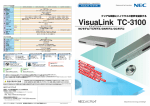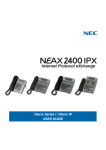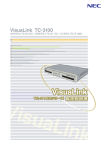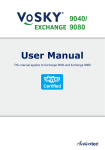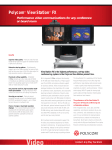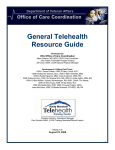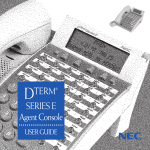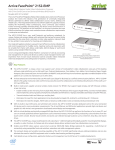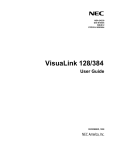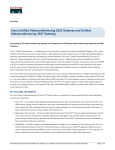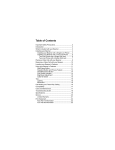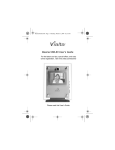Download NEC VisuaLink 128 User's Manual
Transcript
VisuaLink 128/384 General Description NEC America Inc. July, 1998 Stock # 0293739 NDA-24229, Issue 1 LIABILITY DISCLAIMER NEC America, Inc. reserves the right to change the specifications, functions, or features, at any time, without notice. NEC America, Inc. has prepared this document for the exclusive use by its employees and customers. The information contained herein is the property of NEC America, Inc. and shall not be reproduced without prior written approval from NEC America, Inc. NEAX and Dterm are registered trademarks of NEC Corporation. Copyright 1998 NEC America, Inc. Printed in USA All other brand or product names are or may be trademarks or registered trademarks of, and are used to identify products or services of, their respective owners. i Contents Introduction . . . . . . . . . . . . . . . . . . . . . . . 1-1 Overview. . . . . . . . . . . . . . . . . . . . . . . . . . . Features . . . . . . . . . . . . . . . . . . . . . . . . . . . Applications . . . . . . . . . . . . . . . . . . . . . . . . VisuaLink Documentation . . . . . . . . . . . . . . 1-1 1-2 1-5 1-7 Application Configurations . . . . . . . . . . 2-1 Roll-About . . . . . . . . . . . . . . . . . . . . . . . . . . 2-2 Desktop PC. . . . . . . . . . . . . . . . . . . . . . . . . 2-5 Gateway . . . . . . . . . . . . . . . . . . . . . . . . . . . 2-9 Technical Description . . . . . . . . . . . . . . . 3-1 Video & Audio Interfaces . . . . . . . . . . . . . . 3-2 Echo Canceller . . . . . . . . . . . . . . . . . . . . . . 3-2 H.320 Codec. . . . . . . . . . . . . . . . . . . . . . . . 3-2 System Control . . . . . . . . . . . . . . . . . . . . . . 3-3 Line Interface . . . . . . . . . . . . . . . . . . . . . . . 3-3 ...more on H.320 Videoconferencing . . . . . 3-4 Installation & Maintenance. . . . . . . . . . . 4-1 Installation Requirements . . . . . . . . . . . . . . 4-1 Maintenance Requirements . . . . . . . . . . . . 4-2 VisuaLink 128/384 General Description ii Contents Specifications . . . . . . . . . . . . . . . . . . . . . 5-1 General Specifications . . . . . . . . . . . . . . . . 5-1 Operating Modes & Features . . . . . . . . . . . 5-7 VisuaLink 128/384 General Description 1-1 Introduction Overview In today’s fast paced business climate, timely access to accurate information is a critical resource in every successful organization. Often, this information must be communicated face-to-face. However, with busy schedules and remote locations, getting everyone together for a conference can be difficult and expensive. NEC’s VisuaLink products can bring everyone together with an easy and cost affordable solution. VisuaLink sets new standards in group videoconferencing delivering high-end features for about one-fifth the price of other systems. VisuaLink makes videoconferencing practical, easy, and cost effective. Now, moving information between individuals or groups located inhouse or in remote locations is no longer a problem. VisuaLink provides a dynamic solution to deliver video/audio information at the speed of light. VisuaLink 128 and VisuaLink 384 are lightweight, fully integrated videoconferencing Codecs that become the heart of a videoconference system. VisuaLink 128 supports a single 128 Kbps BRI connection (upgradable to 384 Kbps). The VisuaLink 384 supports 384 Kbps, using three BRI connections. These all-in-one units use advanced plug-and-play technology to get up and running in seconds. They connect to most televisions or monitors and can be used with a wide variety of cameras, microphones and other audio/video systems. NEC videoconferencing solutions are powerful productivity tools that provide organizations the ability to address issues and respond to opportunities more quickly. More people can be effectively involved to facilitate a more open and collaborative working environment. NEC is the only vendor who provides products for the full range of videoconferencing-- from rollabout systems and broadcasting equipment to the newest compact videoconference systems. VisuaLink 128/384 General Description 1-2 Introduction Features VisuaLink incorporates features for today’s high performance technologies while making a videoconference system easy and cost effective to operate. Total Integration • single compact unit VisuaLink is a self-contained unit. It integrates hardware and software into one small easy to use box. VisuaLink is easy to setup and likewise easy to troubleshoot any connection problems. Portability • weighs less than 5 lbs.(3 Kg) VisuaLink 128 and VisuaLink 384 are compact units, weighing less than five pounds (3 Kg). Small enough to fit inside an attache or computer case, they have the durability to withstand the rigors of regular travel. This makes them ideal companions for demos, business trips, and off-site meetings. Plug & Play Technology • use with most vendor peripherals VisuaLink systems use Plug & Play technology employing simple generic interfaces. This makes for easy connections to almost any brand of cameras, microphones, and other audio/video components. There is no need for any special equipment with VisuaLink, only a standard ISDN BRI line connection. The VisuaLink systems use industry standard connections for NTSC composite video inputs/outputs (RCA pin), S-Video inputs/outputs (DIN4), and modular jacks (RJ-45) for BRI interfaces. Color-coded connectors for the video and audio with a clearly labeled unit back panel. It takes only seconds to connect all peripheral devices to VisuaLink. Wireless Remote • buttons for calling and hang-up are color coded for quick access The VisuaLink hand-held remote control (infrared) provides access to all functions with a simple button touch. The remote can control all VisuaLink connections/disconnections, conference operations, and environment settings. On-Screen Displays • configuration startup menus for both network and VisuaLink configurations The on-screen messages and icon driven menus make it easy for anyone to operate VisuaLink. Just point the VisuaLink remote and follow the messages and menus on the video display. No special video training is needed. VisuaLink 128/384 General Description Introduction 1-3 Phone-Like Dialing • VoicePoint+ connectivity for ease of dialing For those not wanting to dial using the VisuaLink remote, an NEC VoicePoint+ can be connected to the VisuaLink. (The VoicePoint+ is a tabletop speakerphone unit for conferencing; providing standard keypad, built-in microphone and speaker.) With a VoicePoint+, dialing is as easy as placing a regular phone call. A standard analog phone set can also be used with VisuaLink. To make dialing even easier, VisuaLink provides 130 speed-dial settings. Up to 130 most often used numbers for a videoconference can be preset in VisuaLink. For easy redial, 20 redial numbers are automatically stored for both incoming and outgoing calls Camera Control • local-end can set far-end presets Nine different camera presets can be stored in VisuaLink. The presets allow camera position (pan & tilt), framing (zoom), and automatic focus for various positions in a videoconference. To make this easier, camera presets are stored under identifiable names. With this capability, each preset can store different camera settings matched to each named individual in the conference. A standard feature of VisuaLink is camera voice tracking. Voice tracking automatically moves the camera to the person speaking by using one of the camera presets. Voice tracking automatically detects the audio from a person (from one of three microphones) and selects the preset stored for that person. The camera will then pan, tilt, zoom, and focus (using the preset) to show the person speaking. No longer is a videoconference technician needed to operate a camera controller or video switcher. Echo Canceller • connect up to 3 microphones Voice quality is an important component in videoconferencing. Users will tolerate degraded video, but not degraded audio. The echo canceller improves audio voice quality by eliminating signal echo from long line communications and clipping caused by some narrow band systems. H.320 Videoconferencing Compliance • settings for higher frame rate for smoother motion, or lower frame rate for higher resolution VisuaLink is designed to the International Telecommunications Union (ITU-T) H.320 standard for videoconferencing. Many claim to support this standard, but few products support all options of H.320. VisuaLink is designed to fully support the H.320 standard. This overall standard includes the new option H.263 video standard for higher resolution low bandwidth processing; and the H.261 video standard for lower resolution high bandwidth processing (for compatibility with older systems). Also supported are the standards G.711, G.722, and G.728 for the audio element of videoconferencing. VisuaLink incorporates the latest H.320 technology available and provides backward compatibility in one compact unit. (For additional information on H.320, see Part 3 of this manual: Technical Description - more on H.320 Videoconferencing.) VisuaLink 128/384 General Description 1-4 Introduction Field Upgradable • same software used for both 128 & 384 units Often, keeping up with technology can be a full-time job in itself. Whenever a vendor releases a new software update, you must wait for it to arrive by mail or download patches from a Web site. But this requires time, effort, and expertise. Software in the VisuaLink 128 and VisuaLink 384 units can be upgraded by the user from anywhere. With the “Visual Connect” technology, downloading new software updates is as easy as placing a video call over an ISDN line. Just place a video call from anywhere into the NEC server system. The server takes it from there-performing the download and verifying the integrity of both the software and the VisuaLink unit. There are no options to select and no technical knowledge required. In a matter of minutes, VisuaLink is upto-date and ready to go. In addition to software upgrades, the hardware to upgrade a VisuaLink 128 to a VisuaLink 384 can also be performed in the field. (Refer to the VisuaLink Quick Installation Guide, Stock # 0293885 for the simple upgrade procedure.) PBX Connectivity • NT1 is not needed VisuaLink is totally compatible with NEC NEAX2400 IMX and NEAX 2000 PBX systems. VisuaLink uses a simple BRI interface connection with these PBX systems. Interface with an NEAX PBX does not require an NT1 device. VisuaLink 128/384 General Description Introduction 1-5 Applications The Videoconferencing market is growing rapidly with the more widely available ISDN network and cost effective videoconferencing units such as VisuaLink. Videoconferencing is being adapted to a wide variety of applications. • General Business provides many applications for videoconferencing between distant sites. New opportunities are possible, especially for small groups of people where videoconferencing was too complex or costly before. Smaller project meetings and reviews could now use videoconferencing. Project members or staff “on-the road” could participate using their Laptop PCs (with VisuaLink, video capture card, camera, and BRI interface). • Education provides significant opportunities for in-home instruction, special needs tutoring, at-home corporate training, remote product training, and remote technical assistance for product maintenance. • Remote Interactive Kiosk is possible for public offices, consumer retail, remote site-seeing guides, remote consultation, remote convention & trade show expertise and presentations. • Telemedicine creates the opportunity for in-home care giver to senior citizens or the mobility impaired. Remote medical training for hard-to-get-to locations or smaller medical centers. • New Applications - New Markets will now be opened and realized with VisuaLink. VisuaLink compact systems can be setup at any location for presentations and interactive communications. It can instantly bring in experts (from back home) to help the sales force at a remote convention. The following diagrams illustrate some of the various uses for VisuaLink videoconferencing. VisuaLink 128/384 General Description 1-6 Introduction VisuaLink 128/384 Point-to-Point Applications ISDN BRI Product Training / Marketing Presentations ISDN BRI Telemedicine / Remote Medical Training NEC VisuaLink brings a whole new category of portable and easy to use videoconferencing systems. Point-to-point applications such as remote presentations and remote medical expertise are possible with VisuaLink VisuaLink 128/384 Multi-Point Applications NEC Multipoint Control Unit ISDN BRI Personal Desktop Shared Desk Conference Room VisuaLink provides a more economical solution to bring together shared desk, personal desktop and conference room users, no matter where the location. With VisuaLink, camera, microphone, and a BRI interface, a conference can be “Ready-to-Go” easily and quickly for organizations that could not afford it before. VisuaLink 128/384 General Description Introduction 1-7 VisuaLink Documentation Additional information on VisuaLink can be found in the following NEC publications: • VisuaLink User Manual, Stock # 0293884 • VisuaLink Quick Installation Guide, Stock # 0293885 • VisuaLink Engineering Guide, Stock # 0293886 Consult these documents for additional user, installation, and technical information. VisuaLink 128/384 General Description 1-8 Introduction VisuaLink 128/384 General Description 2-1 Application Configurations VisuaLink is the heart of a videoconferencing system. The compact VisuaLink unit can be configured with a variety of peripheral equipment to address most any videoconferencing need. Three configurations best use the VisuaLink technology to provide solutions to business videoconferencing: • Roll-About • Desktop PC • Gateway These application configurations allow a business to provide videoconferencing from the individual desktop to enterprise-wide. The next sections describe these application configurations. VisuaLink 128/384 General Description 2-2 Application Configurations Roll-About • easily moved, use in active locations The VisuaLink Roll-About application configuration provides a turn-key solution to most general business uses for videoconferencing. The Roll-About includes everything necessary for high quality videoconferencing. Just roll the unit to a conference room, display area, or shop floor and connect a ISDN BRI line. • turn-key solution-- no additional devices needed for a standard videoconference Videoconferencing is no longer limited to fixed installations in a corner meeting room. The Roll-About can easily be moved to any meeting room or conference area. Use Roll-About in active locations in the company including training rooms, production lines, product maintenance/test areas, and sales rooms for product displays to potential customers. VisuaLink Roll-About Configuration Motion Video Camera Video Display Desktop Microphone Power Switch NT1 (optional) (One for 128) (Three for 384) POWER HEADSET POWER LINE B1 B2-B6 VisuaLink 128/384 Power Strip VisuaLink 128/384 General Description Application Configurations 2-3 Roll-About Components The Roll-About incorporates the following components into one easy to move unit for videoconferencing: • Video Cabinet • VisuaLink 128 or VisuaLink 384 Codec • Video Monitor • Motion Camera • Microphone • Cable Kit Video Cabinet Video Cabinet The Roll-About uses a cabinet (RA 128/384) that contains all components that mount in or on the cabinet to make an all-in-one videoconferencing unit. There is additional room in the cabinet for a VCR or Laser Disk player. A power switch is located on the cabinet, so all Roll-About components can be turned on or off with one button touch. The monitor is braced to prevent it from slipping from the top of the cabinet. VisuaLink Codec VisuaLink 128/384 Depending on the requirement, either a VisuaLink 128 or VisuaLink 384 (both include infrared remote control) would be incorporated into the Roll-About. POWER HEADSET POWER LINE B1 B2-B6 Video Monitor Video Monitor The Roll-About includes a Sony Trinitron® 27 or 32 inch video monitor (depending on selected option). The monitor sits on the video cabinet at the appropriate height for most viewing applications. The monitor includes the following features: • On-screen menus for configuring the VisuaLink • Picture-in-Picture (PIP) that allows the local site to view their image seen by the distant end • Built-in speakers for far-end audio VisuaLink 128/384 General Description 2-4 Application Configurations Motion Video Camera Motion Video Camera The motion camera (D30) is a full color camera with the following features: • Effective picture elements of 380,000 (EVI-D30) provides high-resolution video images • High speed pan/tilt/zoom actions controlled by VisuaLink • Automatic focus • Captures the video in the local room Desktop Microphone Microphone A conference type omni-directional desktop microphone (AT841/INT) is supplied with the VisuaLink Roll-About. This sensitive microphone is specifically designed for conference room applications and can pickup most anyone speaking in the conference area. Cable Kit The Cable Kit includes all necessary cables (except cables for connection to an BRI NT1 interface unit). The cables for the NT1 are supplied with that unit option. Options Additional options available with the Roll-About: • NT1 • Graphics Camera • Second Pan/Tilt Camera • Additional AT841/INT Microphones • Second Cabinet • Additional Monitors If using the Roll-About with external ISDN BRI connections, one (VisuaLink 128) or three (VisuaLink 384) BRI NT1 interface units will be required. Additional cameras for motion (one D30 supplied) and a graphics camera can be added to the Roll-About configuration. Still graphics for hardcopy presentations, drawings, or brochures could be presented in a videoconference using a document camera. If the room size is large, additional microphones (up to 3) can be added to the system for better audio pick-up. A second cabinet and monitor can be placed in a strategic location for better viewing. VisuaLink 128/384 General Description Application Configurations 2-5 Desktop PC • also available with control software The VisuaLink Desktop PC application configuration provides a business solution for videoconferencing at the individual desktop. Desktop PC components install and work with a user’s desktop PC system. It includes everything necessary for high quality videoconferencing from the desktop. Videoconferencing is no longer limited to fixed installations in a corner meeting room.The Desktop PC can easily be installed at a individual desktop PC or workstation. Quick connections and software make for ease of use. VisuaLink Desktop PC could be installed on a key manager’s or selected personnel workstations for business unit, production control, quality, marketing/sales, and human resources as examples. This would allow these key managers and select personnel to participate easily in videoconferencing from their own desktop. With the complexity of today’s projects, rising costs, remote subcontractor supervision, and global locations-- VisuaLink Desktop PC can save time, travel expense, and promote better business-tobusiness communication. Desktop PC CCD Desktop Video Camera Desktop Microphone Video Capture Board POWER HEADSET POWER LINE B1 B2-B6 VisuaLink 128/VisuaLink 384 VisuaLink 128/384 General Description Desktop Personal Computer (PC) 2-6 Application Configurations Desktop PC Components The Desktop PC incorporates the following components: • VisuaLink 128 or VisuaLink 384 • Video Capture Board • CCD Desktop Camera • Microphone • Cable Kit • VisuaLink Director software VisuaLink 128/384 Depending on the requirements, either a VisuaLink 128 or VisuaLink 384 (both include infrared remote control) would be supplied as the heart of a videoconferencing system. Video Capture Board The Video Capture board installs in the user’s Pentium (100 Mhz or faster) PC. This PCI bus board provides the video interface between the VisuaLink unit and the desktop PC. CCD Desktop Camera CCD Desktop Camera The CCD Desktop Camera is a full color camera with the following features: • Fixed camera for one or two person shot • Manual pan/tilt for quick shot framing • Manual focus for easy image adjustment • Simple set-up Desktop Microphone Microphone A conference type omni-directional desktop microphone (AT841/INT) is supplied with VisuaLink Desktop PC. This sensitive microphone is specifically designed for conference applications and can pick-up most anyone speaking in the nearby area. Cable Kit The Cable Kit includes all necessary cables (except cables for connection to an BRI NT1 interface unit). The cables for the NT1 are supplied with that unit option. VisuaLink 128/384 General Description Application Configurations 2-7 VisuaLink Director Software This Microsoft Windows 95® software allows the PC to control the VisuaLink 128/384 unit, thereby providing complete control of the videoconference. All functions are provided with easy to use PC screen messages and menus. Options Additional options are available with the Desktop PC application configuration: • NT1 • Graphics Camera • D30 Camera • AT841/INT Microphone If using the Desktop PC with external ISDN BRI connections, one (VisuaLink 128) or three (VisuaLink 384) BRI NT1 interface units will be required. Additional cameras for motion and a graphics camera can be added to the Desktop PC configuration. Still graphics for hardcopy presentations, drawings, or brochures could be presented in a videoconference using a document camera. If needed, additional microphones may be used. Up to three microphones can be used with VisuaLink. Typical desktop configurations would require only one microphone for the desktop user. VisuaLink 128/384 General Description 2-8 Application Configurations Personal Computer Personal Computer Requirements VisuaLink Desktop PC is added to a user’s Personal Computer. The general requirements for a personal computer to support Desktop PC are: • Pentium CPU (100 Mhz or faster) • 16 Mb of system memory • Available PCI bus slot • 16-bit PC graphics board supporting Direct Draw • Sound Board, multimedia subsystem, or powered speakers • Microsoft Windows 95® Laptop PC option Laptop PC option VisuaLink can also be used with a Laptop PC. The Video Capture Board is also available in a PCMCIA card version. Simply insert the PCMCIA card and load the VisuaLink Director software. Connect a camera, microphone and communication line, and videoconferencing is ready to go anytime-anywhere. These components fit nicely into a typical sample-case size carry case. Place the case under the airline seat and head off to the convention, trade show, sales meeting, or subcontractor location. Complete “on-the-road” high quality videoconferencing is now possible with VisuaLink Desktop PC configured for Laptop. VisuaLink 128/384 General Description Application Configurations 2-9 Gateway The VisuaLink Gateway application configuration allows shared VisuaLink 128/384 units between many users. Existing desktop video/ audio equipment users can now have high quality videoconferencing with VisuaLink. VisuaLink units can be configured in one of two typical gateway applications: • ViewPoint VBX Gateway • VisuaLink Direct Connect Either application configuration allows shared VisuaLink 128/384 units between users. This can be a cost effective solution where existing video/audio equipment is already in place. VisuaLink & ViewPoint VBX Gateway A VisuaLink 128/384 unit could be used with a NEC ViewPoint VBX system. The VBX connects all local users, and VisuaLink provides the videoconferencing and interface functions (through the local PBX) to the Telco digital network. VisuaLink is then shared between all users through the VBX. A cost affordable multi-user solution. VisuaLink & ViewPoint VBX Gateway to Telco Digital Network VBX VBX POWER HEADSET POWER LINE B1 B2-B6 Telco VisuaLink 128/384 ISDN PRI BRI ATM T1 ViewPoint VBX Equipment Rack Desktop Videoconferencing VisuaLink can be mounted in a Video Equipment rack VisuaLink 128/384 General Description NEAX 2400 IMX PBX or NEAX 2000 PBX or (Direct Connection to National ISDN1) 2-10 Application Configurations VisuaLink Direct Connect Gateway The VisuaLink Direct Connect Gateway application configuration uses VisuaLink 128/384 units as shared resources for different video/audio users and groups in a facility. The diagram shows VisuaLink units and a cable patch panel mounted in an equipment rack. Video/audio cabling from various areas would connect to the patch panel. The patch panel would connect select areas with a particular VisuaLink unit, depending on user requirements. The VisuaLink units then provide a direct interface to the Telco digital network. This gateway application configuration could utilize existing: Desktops video/audio systems, Roll-Abouts, video/audio meeting rooms, and multimedia areas. With existing equipment, VisuaLink adds high quality videoconferencing and ISDN BRI interface. VisuaLink Direct Gateway to Telco Digital Network Desktops Executive Offices Cable Patch Panel Roll-Abouts BRI VisuaLink 128 Training Classrooms BRI VisuaLink 128 BRI VisuaLink 128 Telco 3-BRI Video Monitor(s) VisuaLink 384 3-BRI VisuaLink 384 ... Room Cameras Microphones Common Equipment Rack Existing Equipment Videoconference Room VisuaLink 128/384 General Description 3-1 Technical Description VisuaLink 128 and VisuaLink 384 employ the latest Codec (coder/ decoder) technology for digital video/audio applications. VisuaLink employs echo cancelling and control system logic to enhance the signal clarity and ease of use. The diagram illustrates the main functional elements of VisuaLink. VisuaLink Functional Block Diagram Video Sources & Monitors Video Interface H.320 Codec Audio Sources & Speaker Audio Interface Line Interface BRI Line Network Interface Echo Canceller System Control Infrared Remote Control, Serial Port, Analog Telephone or VoicePoint+ The following sections provide a technical overview for each of these elements. VisuaLink 128/384 General Description 3-2 Technical Description Video & Audio Interfaces These circuits provide the correct electrical and protocol connections for video sources, video outputs and display monitors, audio sources, and audio outputs. Connections are provided for microphones, headset, line-level audio inputs/outputs, and video inputs/outputs. VisuaLink supports S-video which allows the transmission and reception of higher image resolutions. Echo Canceller Echo can be a real problem on audio circuits. Some systems communicating over long distances can create an echo effect that is very distracting for videoconferencing participants. So distracting, it is considered unacceptable in videoconferencing. A special Echo Canceller circuit eliminates echo effects caused by long distance lines and signal clipping caused by narrow bandwidth equipment. This built-in echo canceller supports a wide range of frequencies from 50 Hz to 7 KHz. H.320 Codec The Codec is the heart of the VisuaLink system; digitizing and compressing video/audio signals, and preparing the signals to be transmitted over digital lines. The Codec, along with the Echo Canceller circuits are designed to support the latest International Telecommunications Union (ITU-T) H.320 standard for videoconferencing. These H.320 options are supported in VisuaLink: Video: • H.261 - supports older low resolution systems with video compression for wide bandwidth transmissions. (This ensures VisuaLink is compatible with these older systems.) • H.263 - supports newer high resolution systems with video compression technology for low bandwidth transmissions. (This provides better picture quality over standard ISDN BRI lines.) Audio: • G.711 - for narrowband transmission (at 48-56 Kbps) • G.722 - for wideband transmission (at 48-56 Kbps) • G.728 - for narrowband transmission (at 16 Kbps) (For additional information, see the section more on H.320 Videoconferencing at the end of this Technical Description.) VisuaLink 128/384 General Description Technical Description 3-3 System Control The System Control circuit manages the many separate functions of VisuaLink. This circuit provides control for the Codec and other devices. Various control devices can be used for VisuaLink: VisuaLink infrared remote control, any analog phone, an NEC VoicePoint+ speaker phone, and a Personal Computer (connected via the RS-232 serial ports). System Control provides three videoconference control modes: • H.281 for multi-location and far-end camera control. • H.243 Multipoint Chairman for multi-location chairman control and browse functions. • T.120 Multipoint Data Sharing & Collaboration compliance for multi-location data conferencing. Line Interface This circuit provides the correct electrical and protocol connections for ISDN-1 BRI line interface. VisuaLink 128 supports one NT-1 (Network Terminal Devices) terminated ISDN-1 BRI line connection. The VisuaLink 384 has an on-board IMUX (Inverse Multiplexer) which supports ISDN BRI bonding calling. This allows users to connect up to three NT1-terminated ISDN BRI line connections to VisuaLink. This makes it possible to combine three signals from three separate BRI lines into one contiguous data channel. VisuaLink 128/384 General Description 3-4 Technical Description ...more on H.320 Videoconferencing ITU-T H.320 specifies technical requirements for narrow-band visual telephone systems and terminal equipment-- typically for videoconferencing and videophone services. The H.320 standard defines the minimum requirements that all videoconferencing manufacturers must support to comply with H.320. These minimum requirements ensure all manufacturer’s H.320 compliant systems will communicate with other. In addition to the minimum requirements, certain optional requirements and standards are also part of, or are used in conjunction with H.320. The implementation of these options is left up to the individual manufacturers. Implementing or not implementing these options can significantly impact the video, audio and transmission quality. This is why not all manufacturer’s H.320 compliant systems operate the same. Five quality factors determine the overall performance of a videoconferencing system: Picture Resolution, Video Frame Rate, Video Processing, Audio Quality, and Data Transmission Rate. A fully compliant (including options) H.320 system addresses these factors: Picture Resolution Picture Resolution is defined by two options: H.261 for low resolution high bandwidth systems and the new H.263 for high resolution low bandwidth systems. Option H.263 supports five resolutions. In addition to Quarter Common Intermediate Format (QCIF) and Common Intermediate Format (CIF) that were supported by H.261 there is SQCIF, 4CIF, and 16CIF. SQCIF is approximately half the resolution of QCIF. 4CIF and 16CIF are 4 and 16 times the resolution of CIF respectively. (VisuaLink supports QCIF and CIF). The H.263 support of 4CIF and 16CIF means a videoconference system could use higher bitrate video processing standards such as MPEG. The H.263 option also corrects some processing flaws and improves performance over H.261 only systems. H.263 should be used in all new systems for optimum performance. Manufacturers who provide compatibility with older systems and peripherals will also incorporate H.261. Video Frame Rate The Video Frame Rate (also known as the number of frames per second (fps)) is the number of times a second the picture image is captured and refreshed. Frame rate is also defined by H.261 and H.263. The H.261 option allows frame rates of 7.5, 10, and 15 fps. (Standard broadcast television is 30 fps). A low frame rate can cause any motion in the picture to appear jerky. H.263 provides higher performance than H.261 by allowing frame rates to 30 fps. This higher frame rate will show much smoother motion and a higher quality image. VisuaLink 128/384 General Description Technical Description 3-5 Video Processing Video Processing is a complex process to reduce the amount of image data that must be processed on any given picture frame. If processing is not used, videoconference performance is reduced by conditions such as complex picture backgrounds, poor camera lighting conditions, and object movement. This ensures a H.320 system processes image objects in the picture that actually move. This lowers significantly the amount of picture information that must be transmitted to the far end (for each frame) and provides a higher quality picture. Audio Three options for H.320 define the audio requirements used for a videoconference: • G.711 - for narrowband transmission (at 48-56 Kbps) • G.722 - for wideband transmission (at 48-56 Kbps) • G.728 - for narrowband transmission (at 16 Kbps) G.711 is telephone quality audio (narrow band - 3 KHz), while G.722 is used for stereo quality audio (wideband - 7 KHz). G.728 offers the highest quality audio providing a narrow band 16 Kbps rate. This is necessary for low bit rate transmissions. A manufacturer’s videoconferencing system that supports all three audio requirements has the greatest capability and flexibility to provide the highest quality video at all data rates. for Example: In a 128 Kbps videoconference connection (typically BRI), the G.722 (48-56 Kbps rate) or G.728 (16 Kbps rate) options would be employed. If audio quality is more important than video quality (48 Kbps for the audio and 80 Kbps for video), the system could use G.722. If video quality is more important than audio quality, the system employs G.728. The audio uses 16 Kbps leaving 112 Kbps for the video. Data Transmission Rate Data Transmission Rates impact the perceived quality of the video picture. The higher the data rate the better the video quality. At T1 speeds (1,536 Kbps) the video quality will be best. However, many connections will not use this rate because of cost. In today’s systems, some users connect at the 768 Kbps rate as a trade-off between high quality video and cost. Most use the 384 Kbps rate. The 128 Kbps rate is becoming more widely used with the increased availability of ISDN service. VisuaLink 128/384 General Description 3-6 Technical Description VisuaLink 128/384 General Description 4-1 Installation & Maintenance Installation Requirements The compact VisuaLink units need no special installation. However, the following should be considered when using or mounting the VisuaLink units. • Place the VisuaLink unit on a stable surface (such as: a desk, or mounted in a video or equipment rack). • VisuaLink may cause possible video interference if placed directly on top of a TV set or monitor. This placement is not recommended. • If placing a phone set, modem, or other device on top of the VisuaLink unit, ensure their weight will not cause damage to the VisuaLink unit. • VisuaLink requires adequate ventilation to properly operate. Do not block the openings on the top and sides of the unit. Maintain a 2-4 inch spacing on the sides to allow for proper unit cooling. • If VisuaLink is to be mounted in an equipment rack, ensure adequate conditions and temperature requirements are met. Refer to the VisuaLink Quick Installation Guide, Stock # 0293885 for complete installation procedures. VisuaLink 128/384 General Description 4-2 Installation & Maintenance Maintenance Requirements There are no user serviceable (see Note) components, modules, or circuits inside the VisuaLink units. If experiencing problems, follow these guidelines: • Ensure a power source is connected to the VisuaLink unit and the power control is set to on. • Check all connections to the VisuaLink unit. Sometimes the wrong cable may be connected or perhaps loosely plugged-in. • Make sure all cables used in a VisuaLink configuration are working properly, with no broken wires or connectors. • Ensure all settings and parameters for VisuaLink operation are correctly set via the on-screen menus. • Verify the VisuaLink unit has adequate ventilation. (see previous section-- Installation Requirements) Note: A user can unpgrade a VisuaLink 128 to a VisuaLink 384. Refer to the VisuaLink Quick Installation Guide, Stock # 0293885. If problems still exist after completing the maintenance guidelines, contact your NEC representative or the NEC Technical Assistance Center. VisuaLink 128/384 General Description 5-1 Specifications General Specifications The following diagrams illustrate the VisuaLink 128 and VisuaLink 384 units. All front and rear panel connections are shown. (See the General Parameters table for dimensions.) VisuaLink 128/384 Front & Rear Panels and Remote Control POWER HEADSET POWER LINE B1 B2-B6 Front Panel + + + O U T MIC1 + MIC2 MIC3 TEL S/T LINE + I N + VIDEO2 VIDEO1 AUDIO Serial1 DC IN 5V Serial2/RMT + - + VisuaLink 128 Rear Panel + + + O U T MIC1 + MIC2 MIC3 TEL S/T LINE S/T LINE S/T LINE + I N + VIDEO2 VIDEO1 AUDIO Serial1 Serial2/RMT + VisuaLink 384 Rear Panel VisuaLink 128/384 General Description DC IN 5V - + Wireless Remote Control 5-2 Specifications VisuaLink 128/384 Top View VisuaLink 128/384 Side View VisuaLink 128/384 General Description Specifications 5-3 General Parameters Parameter Connection Line Type Line Transmission Speed VisuaLink 128 Basic Rate Interface (BRI) National ISDN-1 • Tel • 64 Kbps (B), 2x64 Kbps (2B) • Upgradeable to 384 Kbps Note: Px56 Kbps mode complies with B and 2B VisuaLink 384 Basic Rate Interface (BRI) National ISDN-1 • • • • Tel 64 Kbps (B), 2x64 Kbps (2B) 64, 128, 192, 256, 320, 384 Kbps 56, 112, 168, 224, 280, 336 Kbps Note: Px56 Kbps mode complies with B and 2B Interface One RJ-45 Modular Jack Three RJ-45 Modular Jacks Compression H. 261, H.263 H. 261, H.263 Resolution • CIF (resolution: 352x288) • QCIF (resolution: 176x144) • Annex D (720x480) still graphic transmission / reception • CIF (resolution: 352x288) • QCIF (resolution: 176x144) • Annex D (720x480) still graphic transmission / reception Input / Output Interface • NTSC composite: 1 input, 1 output (RCA pin jack) • S-Video component: 1 input, 1 output (DIN 4-pin) • NTSC composite: 1 input, 1 output (RCA pin jack) • S-Video component: 1 input, 1 output (DIN 4-pin) Video Protcol H/281, NEC video method H/281, NEC video method Control VCCI, D3O VCCI, D3O Camera Compression Echo Control Audio Input / Output Interface • G.711 (3.4kHz) • G.722 (7kHz) • G.728 (3.4kHz) 7kHz built-in echo canceller • Line Audio: 1 input, 1 output (RCA pin jack) • Headset: 1 input, 1 output (stereo mini plug) • Analog phone port: 1 input 1 output (RJ-11 modular jack) • Microphone input port: 3 inputs (mono mini plug) VisuaLink 128/384 General Description • G.711 (3.4kHz) • G.722 (7kHz) • G.728 (3.4kHz) 7kHz built-in echo canceller • Line Audio: 1 input, 1 output (RCA pin jack) • Headset: 1 input, 1 output (stereo mini plug) • Analog phone port: 1 input, 1 output (RJ-11 modular jack) • Microphone input port: 3 inputs (mono mini plug) 5-4 Specifications General Parameters (Cont) Parameter VisuaLink 128 VisuaLink 384 Serial • Ports: 2 Serial (DIN 8-pin) • Speed: 1.2-38.4 Kbps, asynchronous • Start-Stop synchronization • Ports: 2 Serial (DIN 8-pin) • Speed: 1.2-38.4 Kbps, asynchronous • Start-Stop synchronization Control • • • • • • • • Data PC control Camera control T/120 data transmission Generic data transmission PC control Camera control T/120 data transmission Generic data transmission User Interface • Wireless remote control (built-in IR receiver) • PC connected (with serial port) PC software sold separately is required • Telephone (for analog line, 2-line cable, RJ-11) • Wireless remote control (built-in IR receiver) • PC connected (with serial port) PC software sold separately is required • Telephone (for analog line, 2-line cable, RJ-11) Unit Size • Dimensions: 10”(W) x 7”(D) x 2.25” (H) (254 mm x 177 mm x 57 mm) • Weight: less than 5 lbs. (3 Kg) • Dimensions: 10”(W) x 7”(D) x 2.25” (H) (254 mm x 177 mm x 57 mm) • Weight: less than 5 lbs. (3 Kg) Power Requirements Attached external AC adapter: • Input Voltage: 100-240 VAC, 47-63 Hz • Output Voltage: +5VDC @ 5.0 A (max) Attached external AC adapter: • Input Voltage: 100-240 VAC, 47-63 Hz • Output Voltage: +5VDC @ 5.0 A (max) Operating Environment • Temperature: 40°-104° F (5°-40° C) • Humidity: 20-80%, Non-condensing • Temperature: 40°-104° F (5°-40° C) • Humidity: 20-80%, Non-condensing VisuaLink 128/384 General Description Specifications 5-5 External Interface Parameters Parameter VisuaLink 384 • Applicable Line: (1) ISDN BRI (2) High speed digital leased line • Interface: National ISDN-1 • Connector: 1 Modular jack (RJ-45) • Transmission speeds: 1) 64/56 Kbps (B) 2) 2x64/2x56 Kbps (2B) • Applicable Line: (1) ISDN BRI (2) High speed digital leased line • Interface: National ISDN-1 • Connectors: 3 Modular jacks (RJ-45) • Transmission speeds: 1) 64, 128 192, 256, 320, 384 Kbps 2) 56, 112, 168, 224, 280, 336 Kbps Video 1 In • Standard: NTSC composite signal (525 line, 59.94Hz) • Connector: RCA pin jack • Standard: NTSC composite signal (525 line, 59.94Hz) • Connector: RCA pin jack Video 2 In • Standard: S-Video Component signal (525 line, 59.94Hz) • Connector: DIN 4-pin • Standard: S-Video Component signal (525 line, 59.94Hz) • Connector: DIN 4-pin Video 1 Out • Standard: NTSC composite signal (525 line, 59.94Hz) • Connector: RCA pin jack • Standard: NTSC composite signal (525 line, 59.94Hz) • Connector: RCA pin jack Video 2 Out • Standard: S-Video Component signal (525 line, 59.94Hz) • Connector: DIN 4-pin • Standard: S-Video Component signal (525 line, 59.94Hz) • Connector: DIN 4-pin Line Audio In • Input level: -10dBv • Excessive Load Level:+3dB (G711, G728), +9dB (G722) • Input Impedance: High impedance, unbalanced • Connector: RCA pin jack • Input level: -10dBv • Excessive Load Level:+3dB (G711, G728), +9dB (G722) • Input Impedance: High impedance, unbalanced • Connector: RCA pin jack Line Interface Video Input Video Output Audio Input VisuaLink 128 Headset Input Microphone Input (Using recommended headset): (Using recommended headset): • Microphone: Electric condenser type (power • Microphone: Electric condenser type (power supply voltage +25V) supply voltage +25V) • Input impedance:High impedance • Input impedance:High impedance (Using recommended microphone): • Number of connections: 3 • Applicable microphone: Electric condenser type (power supply voltage + 15V) • Impedance: Low impedance VisuaLink 128/384 General Description (Using recommended microphone): • Number of connections: 3 • Applicable microphone: Electric condenser type (power supply voltage + 15V) • Impedance: Low impedance 5-6 Specifications External Interface Parameters (Cont) Parameter Line Audio Out Audio Output Headset Output VisuaLink 128 • Output level: -10dBv • Excessive Load Level:+3dB (G711, G728), +9dB (G722) • Output Impedance: Low impedance, unbalanced • Connector: RCA pin jack (Using recommended headset): • Speaker: Dynamic speaker • Impedance: Low impedance VisuaLink 384 • Output level: -10dBv • Excessive Load Level:+3dB (G711, G728), +9dB (G722) • Output Impedance: Low impedance, unbalanced • Connector: RCA pin jack (Using recommended headset): • Speaker: Dynamic speaker • Impedance: Low impedance Serial 1 • Connector: DIN 8-pin • Communication speed: 1.2~38.4 Kbps, start stop synchronization • Connector: DIN 8-pin • Communication speed: 1.2~38.4 Kbps, start stop synchronization Serial 2 / RMT • Connector: DIN 8-pin • Communication speed: 1.2~38.4 Kbps, start stop synchronization • Connector: DIN 8-pin • Communication speed: 1.2~38.4 Kbps, start stop synchronization Analog Phone Interface • Connecting cable: 2-line cable • Connector: 6-pin modular jack (RJ-11) • Connecting cable: 2-line cable • Connector: 6-pin modular jack (RJ-11) AC Adapter Interface • Voltage: +5VDC • Polarity: + inside, - outside • Connector: EIAJ RC-5320A applicable • Voltage: +5VDC • Polarity: + inside, - outside • Connector: EIAJ RC-5320A applicable Serial Port VisuaLink 128/384 General Description Specifications 5-7 Operating Modes & Features The following provides a summary of the main operating modes and features for VisuaLink. VisuaLink Unit Control VisuaLink can be controlled by one of three devices: • VisuaLink Wireless Infrared Remote Control • VoicePoint+ or Analog Phone Set (connected to TEL jack) • Personal Computer (connected to Serial Port) A buzzer is built into VisuaLink, and will sound when an incoming call is detected. When using a VoicePoint+ or analog phone, their respective ringers will indicate an incoming call. Call Dialing (Originating) Modes • Direct dial calling (by the Remote Control, PC control, analog telephone, and VoicePoint+) • Speed-Dial calling (by the Remote Control, PC control) • Redial calling (by the Remote Control, PC control) VisuaLink provides 130 speed dial number address book for call originating For redial, 30 numbers are automatically saved for both incoming and outgoing calls. VisuaLink can be set to only originate a call and can reject the originating call that does not meet the specific condition. (Originating number filter feature) Example conditions are: • Incoming call only • Inhibits originating a call to the number other than the registered abbreviated dial numbers, • Inhibits originating a call to special number (for example, the number starting from 001). Incoming Call Answer Modes • Manual • Automatic • Selective Selective is a security mode, and will automatically reject an incoming call from phone numbers other than those in the abbreviated dial list.) VisuaLink 128/384 General Description 5-8 Specifications Line Interface Control Originate at a 64 Kbps or 56 Kbps to the North American National ISDN-1. Line Connect Modes • BRI interface with VisuaLink 128/384 and other ISDN equipment (TA, FAX, etc.). • Selects an incoming call in a sub address setting Video Display/Output Modes Display Picture-in-Picture (PIP): • 1/9 transmission video display (mirror display) • 4-position selection is possible. (can be positioned in any of the 4 quads of the TV screen) Video Output: • Preview image • Far-site image • Still picture (snap shot picture: 720x480) On-Screen Menus display settings for line connection, conference control, and speed dialing. A display pointer can be displayed on the local and remote monitor via the IR remote Audio Control Modes • Control of output volume • Transmission audio delay • Manual selection of lip sync • Microphone muting • Audio input selection Audio input is switchable between telephone, headset and audio input mixed with microphone input. The audio input from a VCR, or other playback source, can be mixed with the microphone audio and transmitted to the distant end. The received audio can also be mixed. Data Conference A data conference can be held simultaneously with a videoconference using data conference application software (sold separately). This requires use of a personal computer. VisuaLink 128/384 General Description Specifications 5-9 Multi-Point Conference Control Multi-Point Conference Modes: • Audio Switch • Chairman mode (Video selection, local room transmission, multiple address, remote camera control, pointer control, still picture transmission, remote camera switch) • Selective Receive (Video selection, local room transmission) Multi-point conference control protocol. • ITU-T Recommendation H.243 (International Standard Method using LSD) • NEC own method (NEC's own method using MLP) Camera Control Switching modes: • VisuaLink Remote Control (Local/remote camera control (camera switch, pan/tilt/zoom/preset) • PC software (sold separately) can control a local camera (near end) and remote camera (far end). • Speaker detecting. It detects a speaker from the connected microphones (one of three) and automatically switches to the stored preset for that speaker. Selection for camera type: • VC-C1 • EVI-D30 Remote camera protocol selection: • ITU-T Recommendation H.281 (International Standard Method using LSD) • NEC own method (NEC's own method using MLP) Maintenance VisuaLink employs the following maintenance modes: • VisuaLink firmware can be manually or automatically downloaded from NEC. • Loopback diagnosis capability • Communication log (start date, complete date, duration, fee, reason for the disconnection) can be recorded and used by a PC. VisuaLink 128/384 General Description 5-10 Specifications Serial Port Modes Serial Port 1 • Console port (PC control) • VC-CI camera control port • EVI-D30 camera control port • T.120 data conference data transmission port (PC data conference) Serial Port 2 • Console port (PC control) • VC-CI camera control port • EVI-D30 camera control port • IR Remote A console can be assigned to either Serial 1 or 2. A camera control is also assigned to either Serial 1 or 2. A camera control driver selects either VC-C1 or EVI-D30 camera types. If EVI-D30 is used, a maximum of two units can be controlled in cascade. (Some features may not be available in certain combinations of audio mode, LSD speed, and MLP speed.) VisuaLink 128/384 General Description NEC America Inc. July, 1998 VisuaLink 128/384 General Description Stock # 0293739 NDA-24229, Issue 1









































